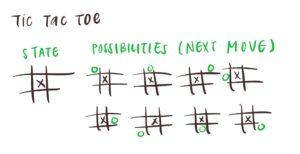Exercise 1
Basic Elements in Settlers of Catan:
- Actions: On their turn, players can collect/trade resources, build roads/settlements/cities, and purchase/ play development cards.
- Goals: Collect Victory Points. First player to collect 10 Victory Points wins.
- Rules: Set up the game board by randomly arranging the hexagonal terrain tiles, the ports/sea tiles, and number tiles on top of each terrain tile. Players start out by each placing down two settlements, each with a connecting road. Then, players take turns rolling the dice and taking actions. With every turn, all players can collect resources if the dice reflects a number on a terrain that one of their settlements is on. The first player that collects 10 Victory Points wins.
- Objects: Resource cards, development cards, two dice, figures to represent roads, settlements, and cities
- Playspace: Game board consisting of randomly placed hexagonal tiles that represent different terrain
- Players: 3-4 (but more can be accommodated with expansions and variations), ages 10+
Exercise 2
Imagine swapping the playspace between the card games Uno and Speed.
- Uno: Imagine that there are now two piles of cards, instead of just one, that players can place a card down on during their turn. This could allow for quicker Uno game since the likelihood that a player has a card that they can play increases with the additional pile. There is also the consideration of whether players can place more than one card per turn. Since there are two piles, can players place a total of two cards per turn? One on each pile? If players can place two cards down, is it fair for players to play two wild cards, one on each pile, to target other players?
- Speed: For speed, imagine there is now only one pile of cards that players can place a card down on, instead of two. As a result, there will be only one pile of face-down cards as well. This could allow for a much slower game since the likelihood that players have a card that they can play decreases. More face down cards will also have to be turned over to accommodate this. This smaller playspace can also defeat the whole purpose of Speed since the game will lose its elements of speed and fast response times.
Exercise 3

Space of Possibilities Visualized for Next Move after Given State
Exercise 4
Ping Pong States (Real-time game)
- Ball in Player A’s court. Player A ready to serve. Player B ready to receive.
- Ball in air.
- Ball bounces in Player B’s court. Player B returns. Player A ready to receive.
- Ball in air.
- Ball bounces in Player A’s court. Player A returns. Player B ready to receive.
- Repeat until one of the players cannot return successfully.
Ping pong is a fast-paced, real-time sport that requires quick reflexes, agility, and physical coordination. The space of possibility in ping pong primarily involves the physical actions and reactions of players to hit the ball over the net, creating various trajectories, spins, and speeds. While ping pong has a limited set of actions (e.g., serves, forehand, backhand), players can vary these actions in terms of spin, speed, and placement. The space of possibility lies in choosing the right tactics for each situation, such as playing aggressively, defensively, or tactically manipulating the ball’s spin. Players receive immediate feedback from the opponent’s actions, which can quickly change the course of the game. The space of possibility is dynamic, with split-second decisions influencing the outcome of each point.
Chess States (Turn-based game)
- All chess pieces in starting position.
- Player A moves pawn from e2 to e4. White pawn on e4. Black pieces still in starting position.
- Player B moves pawn from e7 to e5. White pawn on e4. Black pawn on e5.
- Player A moves knight g1 to f3. White knight on f3. Black pawn on e5.
- Player B moves knight g8 to f6. White knight on f3, Black knight on f6.
- Players continue taking turns making legal moves until checkmate, forfeit, or one player runs out of time.
Chess is a turn-based, strategy board game that relies on planning, foresight, and deep thinking. The space of possibility in chess is predominantly mental, involving a vast number of potential moves and positions. Chess offers a wide array of possible moves for each piece, and the game progresses through a series of decision points. The space of possibility expands with each move, creating intricate and branching decision trees. Chess players must think several moves ahead and anticipate their opponent’s responses. The space of possibility encompasses long-term strategic planning, opening theory, middle-game tactics, and endgame techniques. Players have complete information about the board and pieces, allowing for precise calculations and evaluation of positions. The space of possibility in chess involves exploring different strategies and evaluating the consequences of potential moves.
Comparison (Ping Pong vs. Chess)
Overall, the space of possibility in ping pong centers on physical actions and real-time decision-making, while chess’s space of possibility revolves around strategic thinking, deep planning, and analysis. Ping pong’s space of possibility is more immediate and physical, while chess’s space of possibility is cerebral and analytical. Additionally, ping pong has a limited set of actions but with nuanced variations, while chess has a vast array of possible moves and positions.



